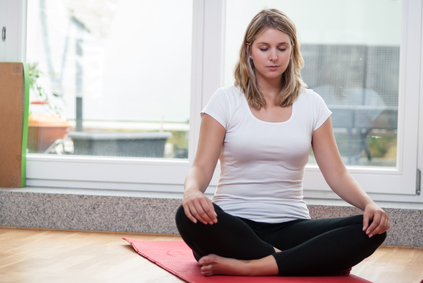Mindfulness Meditation: Boost Its Benefits by Establishing a Routine

By James Allen
While meditation, in its many forms, is beneficial even in small increments, research has shown that to get the long-term health benefits you have to practice regularly. If you’re looking to start a meditation routine, here are five strategies that can help.
1. Setting Your Meditation Goals
Before proceeding, take some time to establish your goals. Be specific. A vague goal, such as “I want to meditate more” isn’t really going to benefit you. With that said, here are a few tips to keep in mind:
Frequency. Ultimately, how often you meditate is completely up to you, but keep in mind that, generally speaking, the more regularly you meditate, the more beneficial it will be.
Duration. How long you meditate is also your choice. Most experts recommend that beginners start with 5 to 10 minutes and work up from there: longer than that, and it may become uncomfortable. And the discomfort reduces the quality of your session.
Set reasonable expectations. A final note on goal-setting: always set reasonable expectations. Start small. If you find that 5 minutes wasn’t enough, you’ll still have a sense of accomplishment, and you can adjust your goals accordingly.
2. Choosing the Right Time
Choosing the right time of day is another critical factor in establishing a meditation routine. Choose correctly, and you’ll optimize your benefits; choose incorrectly, and you could be wasting your efforts. Here are two tips to keep in mind:
Find your zone. When do you feel best? When are you most in the mood to meditate, or in the most desperate need of meditation? If you already know, then you’re one step ahead of the game.
If you don’t know, don’t worry. Find out by periodically checking your mood and energy throughout your day, and do this for a few days. Then, select a time that would be a nice fit for some meditation.
Choose a Plan B. Once you’ve established your prime time, select an alternate one. Things happen throughout the day, but if you have an established Plan B, you can attend to it with a stress-free mind, knowing that you’ve got an alternate time locked in.
3. Create a Meditation Space
Another fantastic way to help you establish and stick with a meditation routine is by creating a dedicated space, a space you use for one purpose, and one purpose only—meditation.
It can be large or small, an entire room, or only a portion of one. The design choices are ultimately up to you. Just make sure that it fosters a relaxing, peaceful environment.
4. Sticking with It
Remember, many benefits of meditation happen when you practice regularly, but sticking with a new habit can be a bit tricky. Here are a two tips to help get you started:
Start a meditation group. Establishing a group offers you support from like-minded people. This gives you support and motivation, and it can drastically increase your chances of actually sticking with it. However, if group meditation isn’t your cup of tea, don’t fret; it’s not a requirement.
If you would prefer to meditate alone, but would still like to have that support, enlist a friend to act as an accountability partner. Ask him or her to contact you a few times a week to make sure that you’re sticking with it and meeting your goals.
Keep a meditation journal. Another great way to help you meet your goals is by keeping a meditation journal. In it, write down the dates and times that you meditated, how you felt after, and if you skipped a session, the reason for it. Studies have shown that people perform better when there is a written record. For example, dieters who keep a written journal of their food intake have been shown to lose more weight than dieters who don’t.
A journal also offers two more benefits. First, writing down how you feel after a session is a great way to reinforce its worth, and in doing so, you make it more likely to repeat. Also, you can use this journal to establish and keep track of a reward system. Want a new yoga mat or cushion? If you can go for one week with no missed days, for example, allow yourself something nice like a new meditation cushion, or some scented candles.
5. Be Reasonable
If you take away nothing else from this article, always, always, always remember that you’re starting this routine as a way to better your life—to enrich your life. Be reasonable with your expectations, and above all, don’t judge yourself if you flounder. Keep your mind open, pursue your goals, and reap in the rewards of your diligent practice.
———————–
James Allen is a research writer and Health, Wellness, and Meditation blogger for Blue Banyan, Australia.
Need help learning mindfulness meditation? Check out Mindfulness Meditation Made Simple: Your Guide to Finding True Inner peace (paperback).
If you enjoyed this article, sign up below for the Blooming Lotus Newsletter and we’ll notify you when the next article is released:





0 Comments